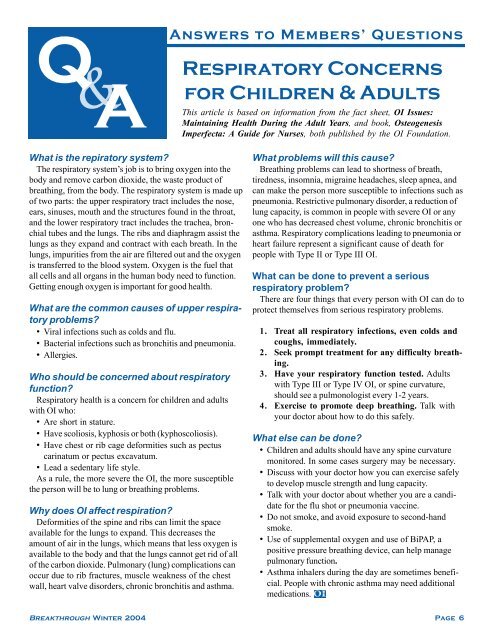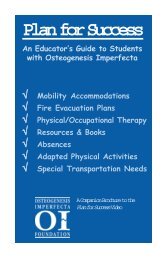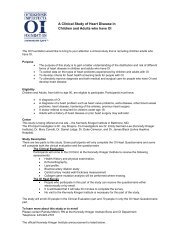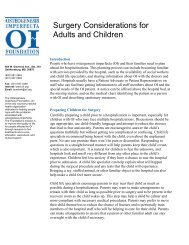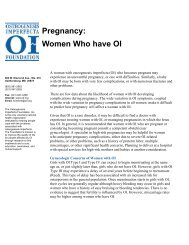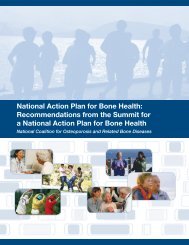Breakthrough - Osteogenesis Imperfecta Foundation
Breakthrough - Osteogenesis Imperfecta Foundation
Breakthrough - Osteogenesis Imperfecta Foundation
You also want an ePaper? Increase the reach of your titles
YUMPU automatically turns print PDFs into web optimized ePapers that Google loves.
Q&<br />
A<br />
Respiratory<br />
Concerns<br />
Answers to Members’ Questions<br />
Respiratory Concerns<br />
for Children & Adults<br />
This article is based on information from the fact sheet, OI Issues:<br />
Maintaining Health During the Adult Years, and book, <strong>Osteogenesis</strong><br />
<strong>Imperfecta</strong>: A Guide for Nurses, both published by the OI <strong>Foundation</strong>.<br />
What is the repiratory system?<br />
The respiratory system’s job is to bring oxygen into the<br />
body and remove carbon dioxide, the waste product of<br />
breathing, from the body. The respiratory system is made up<br />
of two parts: the upper respiratory tract includes the nose,<br />
ears, sinuses, mouth and the structures found in the throat,<br />
and the lower respiratory tract includes the trachea, bronchial<br />
tubes and the lungs. The ribs and diaphragm assist the<br />
lungs as they expand and contract with each breath. In the<br />
lungs, impurities from the air are filtered out and the oxygen<br />
is transferred to the blood system. Oxygen is the fuel that<br />
all cells and all organs in the human body need to function.<br />
Getting enough oxygen is important for good health.<br />
What are the common causes of upper respiratory<br />
problems?<br />
• Viral infections such as colds and flu.<br />
• Bacterial infections such as bronchitis and pneumonia.<br />
• Allergies.<br />
Who should be concerned about respiratory<br />
function?<br />
Respiratory health is a concern for children and adults<br />
with OI who:<br />
• Are short in stature.<br />
• Have scoliosis, kyphosis or both (kyphoscoliosis).<br />
• Have chest or rib cage deformities such as pectus<br />
carinatum or pectus excavatum.<br />
• Lead a sedentary life style.<br />
As a rule, the more severe the OI, the more susceptible<br />
the person will be to lung or breathing problems.<br />
Why does OI affect respiration?<br />
Deformities of the spine and ribs can limit the space<br />
available for the lungs to expand. This decreases the<br />
amount of air in the lungs, which means that less oxygen is<br />
available to the body and that the lungs cannot get rid of all<br />
of the carbon dioxide. Pulmonary (lung) complications can<br />
occur due to rib fractures, muscle weakness of the chest<br />
wall, heart valve disorders, chronic bronchitis and asthma.<br />
What problems will this cause?<br />
Breathing problems can lead to shortness of breath,<br />
tiredness, insomnia, migraine headaches, sleep apnea, and<br />
can make the person more susceptible to infections such as<br />
pneumonia. Restrictive pulmonary disorder, a reduction of<br />
lung capacity, is common in people with severe OI or any<br />
one who has decreased chest volume, chronic bronchitis or<br />
asthma. Respiratory complications leading to pneumonia or<br />
heart failure represent a significant cause of death for<br />
people with Type II or Type III OI.<br />
What can be done to prevent a serious<br />
respiratory problem?<br />
There are four things that every person with OI can do to<br />
protect themselves from serious respiratory problems.<br />
1. Treat all respiratory infections, even colds and<br />
coughs, immediately.<br />
2. Seek prompt treatment for any difficulty breathing.<br />
3. Have your respiratory function tested. Adults<br />
with Type III or Type IV OI, or spine curvature,<br />
should see a pulmonologist every 1-2 years.<br />
4. Exercise to promote deep breathing. Talk with<br />
your doctor about how to do this safely.<br />
What else can be done?<br />
• Children and adults should have any spine curvature<br />
monitored. In some cases surgery may be necessary.<br />
• Discuss with your doctor how you can exercise safely<br />
to develop muscle strength and lung capacity.<br />
• Talk with your doctor about whether you are a candidate<br />
for the flu shot or pneumonia vaccine.<br />
• Do not smoke, and avoid exposure to second-hand<br />
smoke.<br />
• Use of supplemental oxygen and use of BiPAP, a<br />
positive pressure breathing device, can help manage<br />
pulmonary function.<br />
• Asthma inhalers during the day are sometimes beneficial.<br />
People with chronic asthma may need additional<br />
medications.<br />
<strong>Breakthrough</strong> Winter 2004 Page 6


